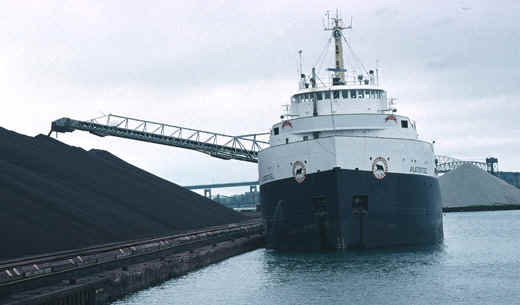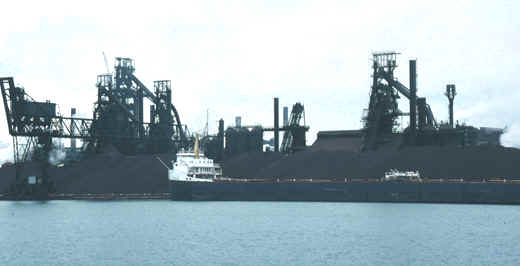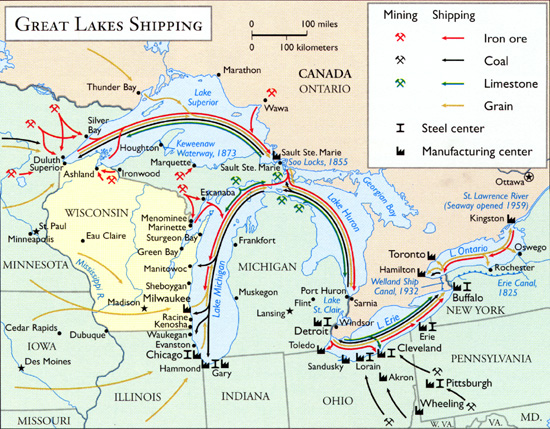IRON ORE / TACONITE SHIPPING
All of the iron ore that is mined in the UP of Michigan and in northern Minnesota is
moved out of the region as taconite pellets. Most of that moves via train cars and
then via large ore freighters, such as the one shown below. Rail transport of
taconite takes place from the Marquette range area (where it is mined) to either Escanaba
or Marquette, where it is loaded onto freighters for shipping.
From these Great Lakes ports, it can travel the lower lakes (which are not frozen as long)
to Detroit, Gary, Cleveland, Hamilton, or elsewhere.
Source: Unknown
In winter, when the Soo Locks are shut down, taconite pellets move out of the mining region by rail to the port in Escanaba, which is open to
shipping year-round.
The first load of iron ore through the Soo Locks amounted to 132 tons in August 1855.
Total ore tonnage that year was 1,447. During the 1860 shipping season 120,000 tons of ore
passed through the Soo Locks. One century later the total volume of downbound iron
recorded at the Soo exceeded 100 million tons.
Source: Unknown
The images below show ore freighters, with their cargo of taconite
pellets, unloading at a blast furnace/steel mill complex in
Sault Ste Marie, Ontario. These ships are self-unloading. 
Source: Photograph by Randy Schaetzl, Professor of Geography - Michigan State University

Source:
Photograph by Randy Schaetzl, Professor of Geography - Michigan State University
Note the large piles of taconite pellets on land, soon to be processed into steel.

Source:
Photograph by Randy Schaetzl, Professor of Geography - Michigan State
University.
The map below illustrates many points about what moves on the lakes, and in
which direction. Note that iron ore moves from the UP to the steel mills of
Gary, Chicago, Detroit, Cleveland, and Buffalo. On their return trips, these ships
may carry coal or limestone.

Source: Unknown
How important was/is the shipping of iron ore to the industrialization of the USA? Read these excerpts from Michigan History magazine.
On 29 May 1890 the wooden-hulled propeller W.R. Stafford left Marquette,
Michigan, with 1,055 tons of iron ore from nearby mines for the bustling docks of
Ashtabula, Ohio, along Lake Erie’s southern shore. On its 654-mile trip, this ship
towed, as usual, its ore-laden consort, the Cleveland. The Stafford plodded
deliberately southward without stopping. After taking the better part of two days to
unload, she took on fuel, had her hold filled with Appalachian coal, and retraced her
route northward to Marquette. There she discharged the coal, took on a new shipment of ore
and repeated the cycle. With few variations, this pattern continued until mid-November
when the Stafford finally laid up for the winter in Buffalo, New York.
Thousands of times that year, hundreds of ships plying the Great Lakes
between the rich ore fields along the southern and western shores of Lake Superior and the
industrial centers in Ohio and Michigan repeated her schedule. The abundance and quality
of the ore these ships transported helped fuel unprecedented industrial growth in the
United States in the last decades of the 19th century. Great Lakes
transportation played a critical role in that growth. Without this link, it is doubtful
the growth of American industry could have occurred as rapidly as it did.
History of Ore Shipping on the Great Lakes
America’s iron industry began along the Atlantic seaboard during the colonial period.
Most of these iron foundries were small and produced iron of inconsistent quality. These
operations came and went rapidly. Demand for iron in America was small and producers’
plants were too modest to realize the advantages associated with economies of scale.
Moreover, they lacked the technical sophistication that allowed Great Britain to dominate
the world iron industry at the time. Poor transportation routes kept producers isolated
from both their sources of raw materials and their markets. They relied on charcoal as
fuel, which had one large disadvantage: the supply was scattered and dwindled once local
timber stands disappeared.
Between 1860 and 1885, American railroads used 1/3 of all iron
produced. Eastern plants, unable or unwilling to modernize, fell even further behind
production schedules under the restraints imposed by east coast mine owners who limited
the amount of ore mined to keep prices artificially high. Therefore, entrepreneurs west of
the Appalachians capitalized on newly discovered coal and ore deposits.
Location, location, location....
The proximity of fuel (coal, coke and charcoal) to the center of iron
production remained the most important influence on the location of 19th-century iron
plants. Since the fuel was bulky and also had a tendency to deteriorate, transport costs
for long distances were often prohibitive. Thus, convenient fuel resources favored the
development of the iron industry near the Pennsylvania coal fields south of Pittsburgh.
A similar situation existed in Alabama. Here, an iron production center
developed around Birmingham, where local iron and coal deposits existed. Unfortunately,
the coal contained a high level of sulphur and produced an inferior grade of iron.
The only other known deposit of ore lay in the inhospitable forests
near the southern shore of Lake Superior. Nonetheless, when William Burt and his surveying
team discovered iron ore along the southern Lake Superior shore in 1844, it hardly caused
a stir. In fact, none of the party even bothered to file a claim on any portion of the
area. "The cause of this indifference," wrote one historian, "doubtless lay
in the knowledge of the almost insuperable obstacles which would have to be overcome
before the iron could reach market." These impediments became painfully evident to
the Jackson Mining Company, the first iron mine in Michigan. In February 1847 it
established a forge near their mine to smelt the ore into transportable bars of rough iron
called "blooms." Investors hoped that shipping iron in this form to Pittsburgh
might make the venture profitable. But transportation costs (fuel) pushed the
company’s completed cost per ton to $200, while the market price at the time was $80.
In sum, the Jackson Mining Company did not have the financial and engineering capabilities
to overcome the problem of distance between the Lake Superior iron ore deposits and the
steel mills far to the south. During the second half of the century, however, three
interrelated developments opened the region.
Because the Jackson Mining Company operated in an isolated and desolate
area 20-30 miles from the lake, they found it difficult to transport supplies into the
region and ore out. Initially, they relied only on sleighs in the winter to haul supplies
and ore. (The heavy ore sank wagons into the soft topsoil at any other time of the year.)
Later, a few primitive roads connected the mines with the lakeshore. Railroads were
decades away and even then proved unprofitable. Water offered company officials the only
economical option for transporting their ore southward. But there was a major snag---the
falls of the St. Marys River at Sault Ste. Marie. The inconvenience at the falls caused
time delays, driving up transport costs. For centuries Native Americans congregated there
to fish and trade, portaging their canoes around the rapids. In the 19th
century, portaging ore-filled boats was out of the question. Workers had to unload both
upbound and downbound ships, haul the cargo 1.25 miles around the falls, and reload it
aboard another vessel. Occasionally, teams of men and horses dragged entire ships out of
the water and towed them around the falls on rollers.
Thus, it comes as no surprise that, shortly after Michigan attained
statehood in 1837, government representatives appealed for federal government funds to
build a canal around the falls. With congressional support from the lower Mississippi
River states, canal proponents finally received the necessary support in 1853. The canal
opened on schedule in June 1855, but its cost ran three times the estimate, at just under
$1,000,000.
The opening of the canal, named the Michigan State Locks, but
eventually called simply the Soo Locks, perfectly coincided with the increased demand for
iron as railroads expanded westward. Between 1850 and 1860, the railroad network in the
United States nearly quadrupled in size. The new locks expedited the shipment of
much-needed iron ore to steel mills in the southern Great Lakes. In return, investment
capital flowed north to the Lake Superior region, expanding mining operations and
improving transportation arteries.
The opening of the Soo Locks permitted the efficient movement of cargo
southward. The insatiable needs of post-Civil War industry for iron, and later steel, led
to a second major improvement in Great Lakes ore shipments---the growth in size, strength
and sophistication of the vessels themselves. Wooden sailing ships dominated commercial
activity on the Great Lakes 200 years. Although they underwent alterations in order to
conform to the Great Lake’s unique characteristics, the shipment of iron ore required
major changes in the vessels’ design. In fact most ships’ captains initially
avoided iron ore shipments. The loading and unloading of the dirty, jagged ore soiled and
disfigured their ships, requiring frequent repairs and continuous cleaning.
Even if shippers were enthusiastic about carrying ore, certain innate
limitations hindered sailing vessels in the ore trade. Rigging and sails took up valuable
cargo space. When in place, the rigging was an obstacle to loading and unloading. Most 19th
century ships had a cargo capacity of about 200 tons, too small to carry a profitable
amount of ore.
In 1869, in response to these problems, Cleveland investors launched a
ship designed especially for the iron ore trade. The R. J. Hackett was
wooden-hulled and steam-powered. Despite its modest 213-foot length, the R.J. Hackett
became the prototype for lake freighters. Its continuous hold with hatches spaced every 24
feet simplified unloading.
The construction of wooden vessels had another problem: it relied on
the readily available oak in the forests along the shores of the Great Lakes. While lumber
was plentiful, the only problems with wooden ships lie in their inherent weaknesses
discussed above. However, once the forestes became depleted of high quality wood, such
ships were doomed, and iron ships took over the cargo demands of the Great Lakes mines.
Three ships launched in 1871 were among the first commercial lake ships
built of iron. These packet/passenger ships demonstrated the strength and flexibility of
design available with metal construction. After the federal government enlarged the Soo
Locks in 1893, builders raced to construct larger ships capable of cargo capacities that
dwarfed their predecessors.
In the 1850s men unloaded ore in much the same way that they loaded
it-with shovels. They scooped the heavy, dusty ore from the holds onto the deck of the
ship. Another gang of workers transferred it to wheelbarrows and rolled it down gangplanks
to waiting canalboats, wagons or railroad cars. The pressing demand for ore in the late
1850s forced innovation. Workers learned to lower tubs of varying sizes into ship’s
hold where shovelers filled them. Horses pulled up each load with the help of a block and
tackle. This process was especially difficult in heavily used ports like Cleveland.
In 1926 economist J. Russell Smith observed that in the United States
economy "a thousand industries must have iron and steel or they cannot go on."
The railroad, the catalyst for the iron industry’s early growth, connected
communities across the country with its network of iron and, later, steel. A large number
of these cities, in turn, produced items of iron and steel transferred by the trains: farm
equipment from Cyrus McCormick’s Chicago factory to rural areas of the Midwest and
Great Plains, the revolutionary typewriter from New York to offices around the country and
spools of barbed wire from midwestern plants to the Great Plains.
The importance of iron in settling the Great Plains during the Gilded
Age is apparent in a letter dated 28 August 1877 by Kansas homesteader Howard Ruede. In
the letter, he provided an inventory of his worldly possessions for his family in
Pennsylvania, listing besides food and staples, "stove, tin wash boiler, 2 iron pots,
teakettle, 2 spiders (a cast-iron frying pan with short legs to stand among coals on the
hearth). 3 griddles, 3 bread pans, 2 tin cups, a steamer, coffee pot, coal oil can,
gridiron, wash basin and 2 lb. Nails." Although Ruede could not then afford one, he
referred frequently to his neighbors’ plows and how important it was for him to
purchase one. He wrote of the various iron tools he used-axes, shovels and pitchforks.
With few exceptions, everything Ruede mentioned was made of iron.
In larger cities, iron and steel made architectural creations possible.
The Commercial Style that emerged in the 1870s relied on iron beams for strength. The
increased used of steel girders and beams allowed further architectural innovations,
culminating in the mighty skyscraper. A growing United States presence, first in the
western hemisphere and later worldwide required a plentiful supply of high-grade steel.
Both battleships and iron-carrying vessels sailing from the Lake Superior mines made use
of steel construction.
These uses made iron production an indispensable ingredient in
America’s national economic growth. Although many factors contributed to the
development of the iron and steel industry, it is difficult to imagine one more critical
than ore carriers, given the geographic proximity of the components necessary for iron and
steel production near the shores of the Great Lakes.
This material has been compiled for educational use only, and
may not be reproduced without permission. One copy may be printed for personal
use. Please contact Randall Schaetzl (soils@msu.edu)
for more information or permissions.